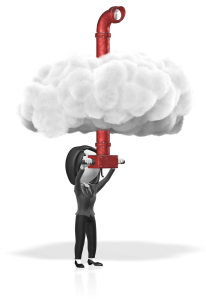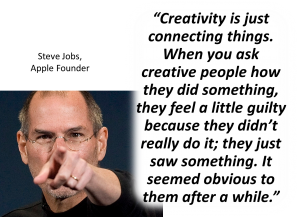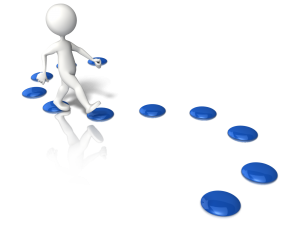(Tuning in is the 6th of a 9-part series on creativity traits.)
Curious: passionate for fresh knowledge; desiring to learn new things
Resilient: capable of overcoming setbacks; able to take risks; ambitious
Evaluative: willing to experiment and evolve your creativity beyond the idea stage
Autonomous: independent; norm-doubting
Tuned in: open and alert to the world around you; highly perceptive
Introspective: driven by innate (intrinsic) rewards; self-accepting
Visionary: having dreams and aspirations; original thinking
Energetic: adept at managing and recharging your energy
Creativity rarely, if ever, occurs in a vacuum. Rather, it comes from tuning in to what is happening around you. And tuning into creative observation demands more than just sight.
 Feel the chair you’re sitting on. Is it hard or soft? Smooth or rough? What about your pet? Your skin? Different textures offer a fertile ground for new discoveries.
Feel the chair you’re sitting on. Is it hard or soft? Smooth or rough? What about your pet? Your skin? Different textures offer a fertile ground for new discoveries.
Take a sip of water (or beer or wine!). Swish it in your mouth and pay attention to how it feels.Take a bite of food. Notice the structure and crunch and quality. How can taste help generate new ideas?
Take a deep breath. Think about pleasant and unpleasant odors that have influenced you in your life. When have smells triggered emotions that might be tapped into as part of invention?
Close your eyes and listen. Do you hear sirens, conversations, or silence? Are you surrounded by music? Why? Try to integrate unique sounds into creative exploration.
Sight, touch, sound, taste and smell all play a role in observation and subsequent innovations. So, be observant using all five of your senses.
Creative observation
 There is no one right way to do creative observation. Some people prefer to go out and experience things before researching data that might explain, affirm or expand on what they experienced. Others prefer to dig into data on trends and ideas before they go out to experience their learning. (Perhaps the former are “right-brain” and the latter are “left-brain” thinkers?) The Coursera course Creativity and Observation emphasizes the importance of observation and divergent thinking in the creative process.
There is no one right way to do creative observation. Some people prefer to go out and experience things before researching data that might explain, affirm or expand on what they experienced. Others prefer to dig into data on trends and ideas before they go out to experience their learning. (Perhaps the former are “right-brain” and the latter are “left-brain” thinkers?) The Coursera course Creativity and Observation emphasizes the importance of observation and divergent thinking in the creative process.
In any event, creative observation involves gathering both soft and hard data, and allowing that data to “incubate” and mature. Remember that ideas spring from other ideas. The more you observe, the more senses you use, the greater the potential for creative insights. It’s an iterative, integrative process.
Creativity is connecting things

Well-known innovators acknowledge this stepping-stone process. Steve Jobs, founder of Apple, stated: “Creativity is just connecting things. When you ask creative people how they did something, they feel a little guilty because they didn’t really do it; they just saw something. It seemed obvious to them after a while.”
There is a bit of serendipity in the process. The more you look for connections, the more you will be ready for them when the time is right. Henry Ford was quoted as saying: “I invented nothing new. I simply assembled into a car the discoveries of other men behind whom were centuries of work … Had I worked fifty or ten or even five years before, I would have failed. So it is with every new thing. Progress happens when all the factors that make for it are ready, and then it is inevitable.”

How to be a better observer
So, how can you become more aware? Start by allowing yourself to be bored occasionally. Don’t feel compelled to spend every moment being “productive” or playing games on your cell phone when you are waiting in line or have a down moment. Stop multitasking.
Pay attention to the people, sights, sounds, and even smells around you. Make it a habit. Listen to nearby conversations (without eavesdropping obnoxiously). Can you spot opportunities for new products, services, or solutions?
Modify your routines
Change your daily habits.Tune to different radio stations (or listen to different music)  during your work commute. Or take alternate paths. Pay attention to sources (news, politics, sports) you don’t normally heed. Notice things you never paid attention to before. Challenge yourself to experience something unfamiliar each day – whether it’s striking up a conversation with a person you’ve just met or eating at a new restaurant.
during your work commute. Or take alternate paths. Pay attention to sources (news, politics, sports) you don’t normally heed. Notice things you never paid attention to before. Challenge yourself to experience something unfamiliar each day – whether it’s striking up a conversation with a person you’ve just met or eating at a new restaurant.
Become an expert
Work to become more of an expert within the area you are trying to be creative. Listen to TED Talks (or similar sources on YouTube). Network with experts and lead users whenever you can. Look for mutual advantages within the network to keep it dynamic. Compile statistics, projections, assumptions, forecasts, expectations, and other data to inspire and inform your creative efforts. Feel free to beg, borrow and steal ideas (ethically and legally, of course!).
Avoid NIH
Creativity suffers when a Not-Invented-Here (NIH) attitude dominates. Don’t allow your ego to be an obstacle to new ideas. Be open to the unexpected. Creativity doesn’t just happen on command. Rather, the more you tune into the world around you, the more likely you will have provided your subconscious with the necessary stimuli to connect concepts in creative ways when the time is right.
Where to from here?
After your creative observation, when is the “right time” to take the next step? The time is right for creativity when you are motivated – and I’ll discuss motivation in the next post.
